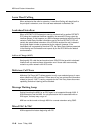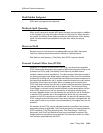
ASAI and Feature Interactions
12-44 Issue 7 May 1998
Integrated Services Digital Network
(ISDN)
ISDN/Basic Rate Interface (BRI)
The Third Party Auto Dial calls follow Integrated Services Digital Network (ISDN)
rules for the originator’s name and number. The Call Initiated Event Report is not
sent for
en-bloc
BRI sets.
ISDN/Primary Rate Interface (PRI)
Primary Rate Interface (PRI) facilities may be used for either inbound or outbound
adjunct-monitored calls.
An incoming call over a PRI facility provides the calling and called party
information (CPN/BN/DNIS), which is passed on to the adjunct in the Call Offered
to Domain Event Report and the Route capabilities as well as to events (for
example, Alerting or Connected).
An outgoing call over a PRI facility provides call feedback events from the
network.
PRI trunks should be accessed by switch-classified calls using AAR/ARS. The
use of TACs to access PRI trunks is not supported.
When a switch-classified call is launched over an ISDN/PRI trunk, such a trunk
must connect to the network on the “user” side. If the trunk is administered as
“network” (as in the case of a private network with cascading ECSs), the call will
fail; that is, the “user” end will drop the call because the “network” trunk does not
provide a CONNect ACKnowledgement.
If Call Classification after Answer Supervision is disabled, switch-classified calls
will always use a call classifier on PRI facilities, whether the call is interworked or
not. Although these facilities are expected to report call outcomes on the “D”
channel, often interworking causes loss or delay of such reports. Progress
messages reporting “busy,” “SITs”, “alert,” and “drop/disconnect” cause the
corresponding event report to be sent to the adjunct. For switch-classified calls,
the “connected” number is interpreted as “far end answer” and is reported to the
adjunct as the Answered Event Report when received before the “answer”
indication. When received after the call classifier has reported an outcome, it is
not acted on. If Call Classification after Answer Supervision is enabled in
Feature-Related System Parameters, the ECS will rely on a received ISDN PRI
Connect message to determine that the call has been answered. If this option is
set, and a Progress message is received, a call classifier will not be attached to
the call. Hence, the ECS will not be able to detect in-band tones such as “busy,”
“SIT,” or “alert” in this instance.


















